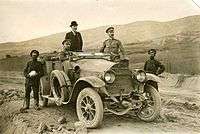Trebeništa
Trebeništa (Macedonian: Требеништа) is an ancient necropolis dating from the Iron Age, i.e. around the 7th century BC.[1] The site is located near Trebeništa in modern-day North Macedonia.[1] It is believed that the necropolis was used by the people from the ancient town of Lychnidos. Whether product of Illyrian,[2] Thracian, or a mixed Thraco-Aegean civilization,[3] its characteristics suggests some cultural continuity throughout a wide area, despite there lived different tribes.[4]

Modern discovery
Trebeništa was discovered by Bulgarian soldiers during World War I Bulgarian occupation of Kingdom of Serbia in 1918. The Bulgarian government sent the archaeologist Karel Škorpil to organize excavations. The artifacts were later researched by the archaeologist Bogdan Filov. Since then, large amounts of graves, five golden masks,[5] and some iron earrings and plates have been found. The excavations continued in 1930-1934, 1953-1954 and 1972 in Yugoslavia. The finds are housed now in the Archaeological Museums in Ohrid, Sofia and Belgrade.
A number of artifacts excavated in the necropolis are said to be imported from ancient Greece while the rest are of a local Thracian-barbarian origin with Greek influences.[3] Archeological findings include a bronze Krater, a Corinthian helmet, Illyrian type helmets[6] and golden funeral masks reminiscent of Aegean culture.[3]
A corrupt passage from Greek historian Strabo suggests that the Thraco-Illyrian tribe of Peresadyes and the Illyrian tribe of the Enchelei allied to create a new state in the area of modern Ohrid. If that suggestion is correct then the royal cemetery located in the necropolis is that of the Peresadyes.[1]
A golden mask from Trebeništa is depicted on the obverse of the 500 Macedonian denar banknote, issued in 1996 and 2003.[7]
See also
Sources
- Lewis, D. M.; Boardman, John (1994-01-01). The Cambridge Ancient History. Cambridge University Press. ISBN 9780521233484.
- Michail Yu Treister as ed., Hammering Techniques in Greek and Roman Jewellery and Toreutics; Volume 8 of Colloquia Pontica Series; BRILL, 2001, ISBN 9004121501, p. 31.
- Ilieva, Pavlina, and Petia Penkova. "Funeral golden mask and hand with a ring The necropolis of Trebeniste." ArcheoSciences. Revue d'archéométrie 33 (2009).
- Carol J. King, Ancient Macedonia; Routledge, 2017, ISBN 135171032X, p. 3.
- "Macedonian Golden Funeral Masks from the City of Angels & Light - Ohrid". Retrieved 2016-10-21.
- Das goldene Antlitz des unbekannten Makedonen-königs.
- National Bank of the Republic of North Macedonia. Macedonian currency. Banknotes in circulation: 500 Denars Archived 2009-04-08 at the Wayback Machine (1996 issue) & 500 Denars Archived 2009-04-08 at the Wayback Machine (2003 issue). – Retrieved on 30 March 2009.
Bibliography
- B.D.Filow, K.Schkorpil, Die archaische Nekropole von Trebenischte am Ochrida-See, Berlin und Leipzig 1927.
- La nécropole archaïque de Trebenischte, Extr. de la Revue Archéo., janvier-avril 1934. Vulic (N.)
- WHO WERE THE AUTHORS OF THE TREBENIŠTE CULTURE AND THE GOLD FUNERAL MASKS, Nade Proeva, Ph.D.
- Viktorija Sokolovska, Etnickite nositeli na Trebeniskata Nekropola, Skopje/Ohrid 1997 (Summary in English)
| Wikimedia Commons has media related to Trebeništa. |